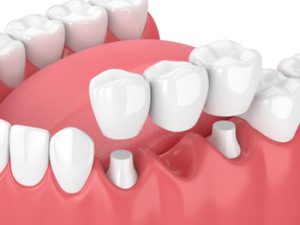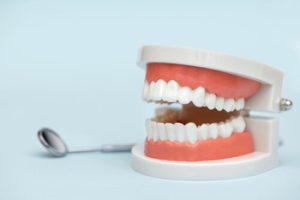Losing one or more teeth does more than leave a gap in your smile. It can change the way you eat, make speaking feel awkward, and chip away at your confidence every time you look in the mirror. That’s where dental bridges come in. These versatile dental prosthetics are designed to bridge the gap left by missing teeth. Whether you’re considering replacing a single missing tooth or multiple, understanding the types of dental bridges available can help you make a proper decision.
This blog will explore the different dental bridge types, how they work, when they’re recommended, and how they compare. Let’s get started.
What Are Dental Bridges?
Dental bridges are strong, long-lasting restorations designed to replace one or more missing teeth by filling the space with artificial teeth known as pontics. These are supported by nearby natural teeth or dental implants, providing a secure and functional replacement. A dental bridge allows you to chew and speak comfortably while bringing back the natural look of your smile. Each bridge is custom-made to match the shape and colour of your existing teeth, allowing it to blend in beautifully with your natural appearance.
Why Replacing Missing Teeth Matters
Living with a missing tooth gap might seem manageable at first, but it can lead to complications if left untreated. The surrounding teeth may shift out of place, leading to misalignment. This creates pockets that trap food, increasing the risk of tooth decay and gum disease.
Tooth loss can also weaken your bite, affect your speech, and contribute to jawbone loss over time. Replacing teeth with a dental bridge helps preserve your oral health, supports the underlying gum tissue, and restores full functionality.
Let’s Break Down the Main Types of Dental Bridges
Choosing the right bridge depends on your unique needs. Here are the most common types of dental bridges available today:
1. Traditional Dental Bridges: The Most Common Option
What is it?
 Traditional dental bridges are among the most common choices for replacing missing teeth. They involve one or more pontic teeth supported by dental crowns, which are securely placed over two abutment teeth on either side of the gap.
Traditional dental bridges are among the most common choices for replacing missing teeth. They involve one or more pontic teeth supported by dental crowns, which are securely placed over two abutment teeth on either side of the gap.
Best for:
People who have healthy natural teeth adjacent to the missing tooth gap.
Pros:
- Strong and long-lasting
- Look and function like natural teeth
- Suitable for replacing posterior or front teeth
Things to Consider:
For this type of bridge, your dentist must file down the two abutment teeth to place the dental crowns. This may not be ideal if those teeth are perfectly healthy, making it less conservative than other options.
2. Implant-Supported Bridges: The Long-Term Investment
What is it?
This bridge is secured using dental implants, so there’s no need to alter or rely on your natural teeth for stability. Each implant acts like an artificial tooth root and is topped with a crown or a pontic tooth.
Best for:
Individuals with several missing teeth in a row or those who want to conserve the surrounding healthy teeth.
Pros:
- Does not require altering any existing teeth
- Very strong and secure
- Stimulates jawbone and supports gum health
- Can replace multiple missing teeth effectively
Things to Consider:
Implant-supported bridges require surgery and a longer healing period. However, they are often considered the most stable and durable option.
3. Temporary Dental Bridges: A Short-Term Solution
Before receiving your permanent restoration, your dentist might offer a temporary dental bridge. This helps protect the exposed teeth and maintain function while your custom bridge is being crafted. It is especially common after the initial steps of the dental bridge procedure.
Why So Many Smiles Rely on Dental Bridges
Dental bridges do more than just fill in a gap; they restore balance to your mouth and confidence in your smile. Whether you’re missing a single tooth or several, here’s why dental bridges are a go-to solution for many Australians:
1. Restore functionality
Chewing, biting, and even speaking can become a challenge when teeth are missing. Dental bridges restore these everyday functions, letting you enjoy your meals and conversations without hesitation.
2. Blend Seamlessly with Your Smile
Bridges are customised to resemble the colour, size, and shape of your natural teeth. When done right, they’re virtually indistinguishable from the real thing.
3. Prevent Teeth from Shifting
When a tooth is lost, the remaining teeth can start to drift out of place. A dental bridge keeps your bite aligned and helps prevent future dental complications.
4. Support Facial Structure
Missing teeth may lead to sagging cheeks and give your face an older, sunken appearance over time. Dental bridges support the natural shape of your face by helping to keep your lips and cheeks in place.
5. A Fixed, Stable Solution
Dental bridges are securely fixed in place, unlike removable dentures. There’s no slipping, clicking, or need to take them out at night, just a stable, comfortable solution that feels much like your natural teeth.
6. Quick and Minimally Invasive
For patients who aren’t suitable for dental implants or prefer a less invasive option, bridges can be placed relatively quickly without surgery. Traditional or cantilever bridges can often be completed in just a few visits.
7. Help Maintain Oral Health
By filling in the gap, a bridge helps prevent food and bacteria from collecting in hard-to-clean areas. When paired with good dental hygiene, bridges support better gum and tooth health overall.
How Does the Dental Bridge Procedure Work?
Getting a dental bridge might sound complex, but it’s a straightforward process once you understand the steps. Your dentist will walk you through everything, but here’s a general overview of what to expect during the dental bridge procedure:
1. Your Initial Consultation
It all starts with a comprehensive dental examination. Your dentist will check your oral health, assess the missing tooth gap, and determine whether you’re a good candidate for a dental bridge. Your dentist often takes X-rays or digital scans to evaluate the health of your surrounding teeth, gums, and jawbone.
2. Preparing the Abutment Teeth
If you’re receiving a traditional bridge, the natural teeth must be prepared on either side of the gap (called abutment teeth). This involves gently reshaping these teeth so that crowns can be securely placed over them. It ensures a snug, natural fit for your new bridge.
3. Taking Impressions
Next, your dentist will take precise impressions of your mouth. These are delivered to a dental laboratory where your custom bridge is created. The goal is to create a bridge that fits comfortably and matches your existing teeth for a natural, seamless appearance.
4. Fitting a Temporary Bridge
While your permanent bridge is being crafted, a temporary dental bridge may be placed to protect your prepared teeth and maintain your ability to chew and speak properly. It’s not as durable as the final one, but it keeps things functional in the meantime.
5. Placing Your New Dental Bridge
When your permanent dental bridge is ready, you’ll return to the clinic for the final fitting. Your dentist will remove the temporary bridge, check how well the new one fits, and make any needed adjustments to ensure it feels comfortable and looks natural. Once everything is just right, the bridge will be permanently cemented into place.
6. Post-Placement Care and Check-up
You’ll likely have a follow-up visit to make sure everything is settling in well. Your dentist will give you instructions on how to care for your new dental bridge, including proper cleaning techniques and tips for maintaining good dental hygiene.
What Makes a Good Candidate for Dental Bridges?
 You may be a good candidate if you:
You may be a good candidate if you:
- Have one or more missing teeth
- Maintain good dental hygiene
- Have healthy adjacent teeth or are suitable for implants
- Are looking for a long-lasting solution for replacing teeth
A dental bridge might not be suitable for people with poor gum health, extensive tooth decay, or weak existing teeth.
Dental Bridges vs Other Tooth Replacement Options
When you’re dealing with tooth loss, choosing the right solution can feel overwhelming. There are several effective ways to replace missing teeth, and each option has its pros and cons. Let’s compare dental bridges with other common tooth replacement methods so you can make a confident, informed decision.
Dental Implants: The Gold Standard
Dental implants are considered one of the most reliable and advanced methods for replacing missing teeth. A titanium post is surgically fixed into the jawbone, serving as an artificial root to support a crown or bridge. For patients missing several teeth in a row, an implant-supported dental bridge offers a strong and lasting solution without relying on neighbouring teeth.
Benefits:
- Preserves jawbone and gum health
- Doesn’t affect surrounding teeth
- Extremely stable and long-lasting
Considerations:
- Involves surgery and healing time
- Higher upfront cost
- It may not be suitable for patients with bone loss or certain health conditions
Partial Dentures: A Removable Alternative
Partial dentures are a commonly chosen solution for replacing teeth, especially when multiple teeth are missing in various areas of the mouth. They sit on the gums and are usually secured with clasps that hook onto the remaining natural teeth.
Benefits:
- More affordable
- No alteration to existing teeth is required
- Removable for easy cleaning
Considerations:
- Less stable than fixed options
- It may feel bulky in the mouth.
- Needs to be removed and cleaned daily
What’s the Best Option for You?
There’s no one-size-fits-all answer. If you’re looking for a cost-effective, fixed solution that offers a natural look and feel, dental bridges are often ideal. Implant-supported bridges may suit those who want a more permanent result without relying on existing teeth. If flexibility and affordability are your top concerns, a removable partial denture might be more appropriate.
The best way to determine the right fit is by discussing your needs, lifestyle, and oral health with your dentist. They’ll help guide you to the most beneficial solution while preserving your long-term dental health.
How Long Do Dental Bridges Last?
With proper care, most dental bridges can last between 10 to 15 years or longer. The lifespan of your dental bridge depends on various factors, including:
- Material used (e.g. porcelain fused to metal, zirconia)
- Your oral hygiene habits
- Frequency of dental check-ups
- Avoiding habits like nail biting or chewing ice
Proper Dental Bridge Care: Keep Your Smile Strong
To extend the life of your dental bridge and protect your oral health, stick to these tips:
- Brush twice daily with fluoride toothpaste.
- Floss carefully, including under the bridge, using special floss or water flossers.
- Rinse with an antibacterial mouthwash
- Make sure to see your dentist reistgularly for check-ups and professional cleanings to keep your bridge and overall oral health in good shape.
- Avoid biting hard objects with the bridge area.
Keeping up with good oral hygiene is essential for preventing gum disease, decay in the abutment teeth, and other problems that could compromise the stability of your dental bridge.
Are There Any Risks with Dental Bridges?
Dental bridges come with potential risks, like all dental treatments, especially if proper care is not maintained. These may include:
- Damage or decay to abutment teeth
- Loosening of the bridge over time
- Gum irritation or inflammation
- Bite misalignment if the bridge shifts
These risks are often preventable with proper care and regular dental visits.
Frequently Asked Questions About Dental Bridges
Can you replace an old dental bridge?
Yes. If your bridge is damaged, loose, or decayed underneath, your dentist can remove it and fit a new dental bridge.
Are dental bridges painful?
The procedure is generally comfortable, especially with anaesthesia. Some temporary sensitivity may occur after placement.
How much do dental bridges cost?
The cost depends on the type of bridge, number of teeth being replaced, materials used, and whether implants are involved. Your dentist will be able to provide an accurate quote after a thorough assessment of your individual needs and oral health.
Are dental bridges suitable for children?
Bridges are not usually recommended for children as their jaws are still developing. Alternatives like space maintainers may be considered.
Final Thoughts: Choosing the Right Dental Bridge for You
 Whether you’re missing a single tooth or several, there’s a dental bridge that can help restore your smile and function. From traditional fixed bridges to implant-supported dental bridges, each option comes with its own set of benefits tailored to your dental health needs and personal preferences. Discussing these choices with your dentist is the best way to find a solution that aligns with your long-term oral health and lifestyle.
Whether you’re missing a single tooth or several, there’s a dental bridge that can help restore your smile and function. From traditional fixed bridges to implant-supported dental bridges, each option comes with its own set of benefits tailored to your dental health needs and personal preferences. Discussing these choices with your dentist is the best way to find a solution that aligns with your long-term oral health and lifestyle.
Ready to explore your options? Book a consultation with Beyond Infinity Dental at (02) 8806 3799 to discover which type of dental bridge best suits your smile, lifestyle, and long-term oral health needs.
Note: Any surgical or invasive procedure carries risks. Before proceeding, you should seek a second opinion from an appropriately qualified health practitioner.
References
- FDI World Dental Federation. (n.d.). How to practise good oral hygiene. Retrieved from https://www.fdiworlddental.org/how-practice-good-oral-hygiene
- Cleveland Clinic. (n.d.). Dental bridges. Retrieved from https://my.clevelandclinic.org/health/treatments/10921-dental-bridges
- Mayo Clinic. (n.d.). Dental implant surgery. Retrieved from https://www.mayoclinic.org/tests-procedures/dental-implant-surgery/about/pac-20384622
- NHS. (n.d.). Tooth decay. Retrieved from https://www.nhs.uk/conditions/tooth-decay/#:~:text=Tooth%20decay%20happens%20when%20bacteria,gums%20from%20an%20early%20age
- Colgate. (n.d.). Dental impressions: What to expect. Retrieved from https://www.colgate.com/en-us/oral-health/bridges-and-crowns/dental-impressions-what-to-expect









